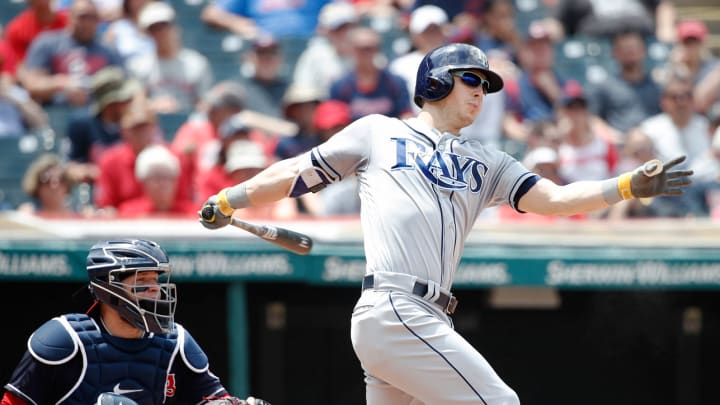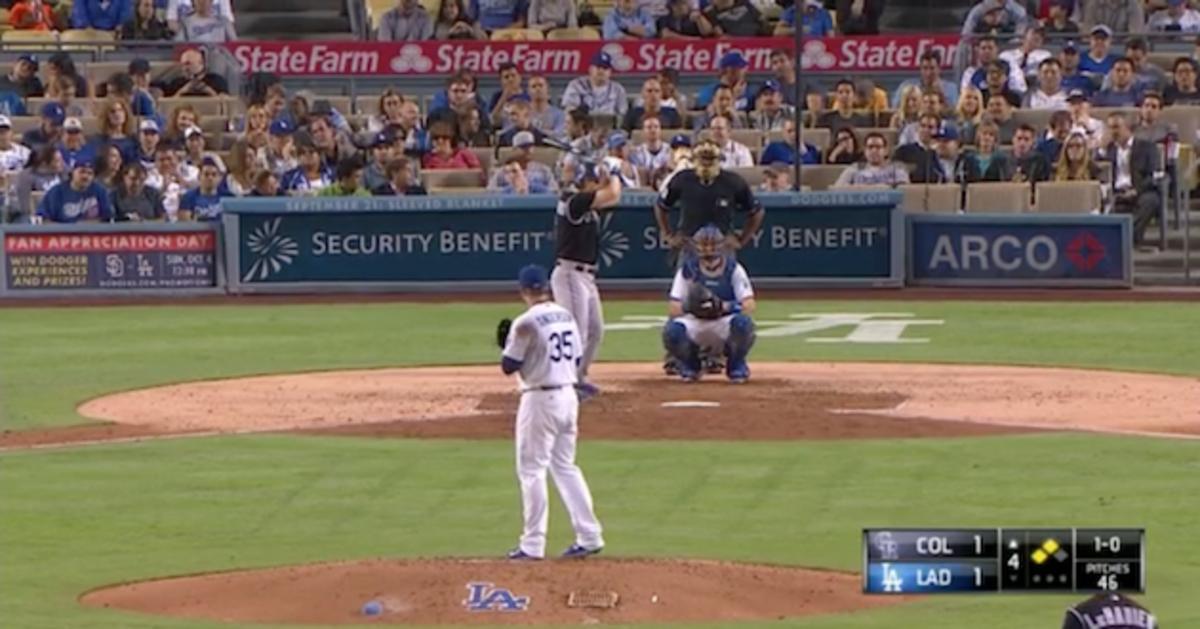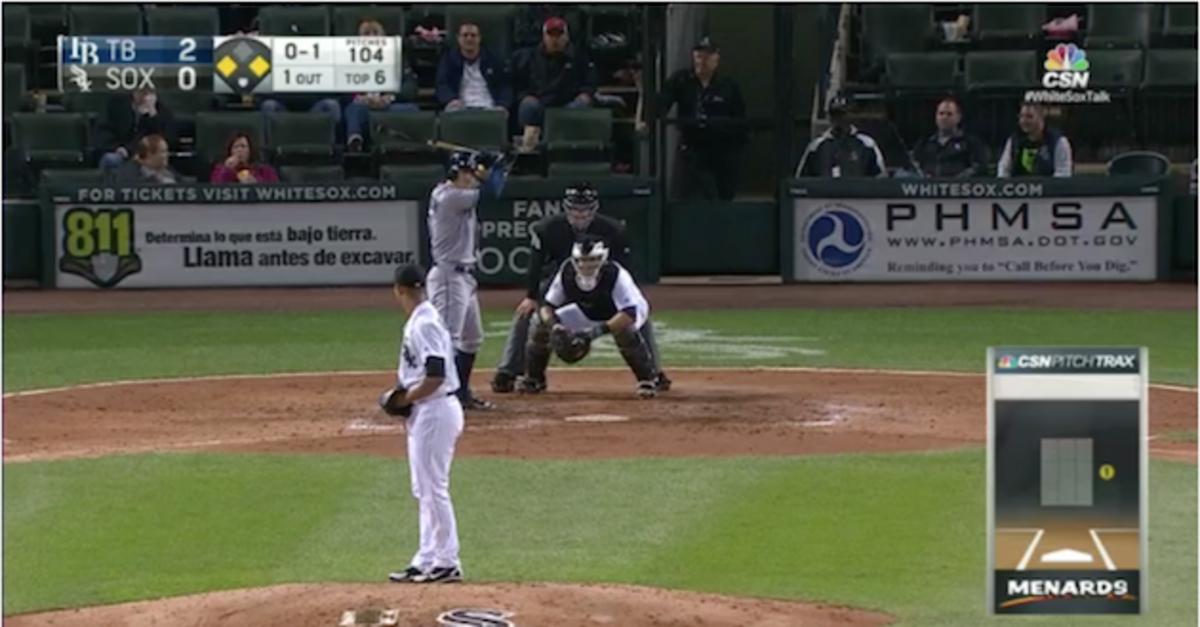Corey Dickerson is baseball's hottest hitter

Through the first four seasons of Corey Dickerson’s career, one facet of his game appeared an immutable fact: He was a black hole against lefties. From 2013, when Dickerson played in 69 games as a rookie for the Rockies, through 2016, his first season with the Rays, Dickerson slashed .244/.290/.354 with six homers in 310 plate appearances when he lacked the platoon advantage. Conversely, he mashed righties to the tune of a .288/.334/.552 with 57 homers in just shy of 1,100 plate appearances. Heading into his age-28 season, it seemed safe to say Dickerson was lethal on the long end of a left-right platoon, but couldn’t be trusted with a southpaw on the mound.
Last season added another checkmark against Dickerson’s viability as an everyday player. After spending the first four seasons of his career in the thin mountain air, it was fair to wonder how he would handle trading Coors Field for Tropicana Field as his home park. After all, Dickerson hit .360/.414/.679 at home during his tenure with the Rockies. Those fears appeared founded after he hit .213/.273/.377 at his new home in Tampa last year. Without 81 games at Coors to keep him afloat, and with his issues against lefties still acute, Dickerson entered the 2017 season as untrustworthy as ever.
It only makes sense, then, given the nature of baseball, that Dickerson is having the best season of his career. He’s slashing .345/.394/.644 with 12 homers, 12 doubles, 23 RBI and 31 runs. Through Monday, Dickerson leads the majors with 60 hits and 112 total bases, and his .345 batting average is tops in the AL. He’s on pace for 40 homers, 44 doubles, 218 hits, 81 RBI and 110 runs, all rounded down to the nearest whole number. Should he maintain that pace, he’d be the fourth player in MLB history to hit all five of those thresholds in the same season. The other three are Lou Gehrig, Rogers Hornsby and Chuck Klein, who did it twice. That’s pretty good company for a guy who, two months ago, seemed no better than a platoon player who couldn’t buy a hit in his home stadium.
Forget velocity, the curveball's resurgence is changing modern pitching
Dickerson has shed his platoon label and is now thriving against lefthanded pitching. He has still been better on the road, where he’s slashing a Ruthian .359/.405/.705, but the Rays can live with him hitting .333/.385/.594 at home. What’s more impressive, though, is what he has done against lefties. Dickerson carries a .365/.421/.577 batting line with one homer and six doubles against lefties this season.
It’s impossible to overstate how dramatic a change this is. Dickerson hit .244/.290/.354 in the first 310 plate appearances against lefties of his career. Assuming a normal distribution of right-handed and left-handed pitcher opponents, 310 trips to the plate against lefties translates to about two full seasons. Dickerson wasn’t just bad against lefties. He was one of the worst hitters in the league against them. From 2013 through 2016, Dickerson amassed a .285 wOBA (weighted on-base average, designed to measure a player’s overall offensive contributions per plate appearance) with lefties on the mound. That ranked 229th out of the 267 players who had at least 300 plate appearances against lefties across those four seasons. This year, his .433 wOBA against lefties is good for 19th in the league.
A quick look at Dickerson this year compared with previous seasons can rule out small-sample variance as the driver of the change. Let’s start with the still frames. The following screenshots are in chronological order, with one per season beginning in 2015.
2015:

2016:

2017:

The differences should jump out at you right away. Before this year, Dickerson was totally upright when he faced lefties. His hands started out above his head, with his right bicep just below his mouth, and his stance was slightly open.
This season, nothing is what it once was. His front leg is stiff and nearly entirely straight, but he has a deep bend in his back knee. His hands are even with his back ear, and he starts with the bat on his shoulder before going into his load.
That would be enough for us to trust that Dickerson had made a substantive change that altered the way he’s seeing pitches from lefties. But it’s not even close to the end of the story. For that, we need to roll the video and check out his swings. We’ll start with 2015 and 2016.
2015:
2016:
Before this season, Dickerson deployed the same huge leg kick he still uses against righties. He had a ton of bat movement before the pitch and, because of how he set up, the first movement for his hands necessarily had to be down. Most importantly, look how long that swing is. That is a huge, looping swing that creates holes on the inside part of the plate, and all too often made Dickerson late on pitches he likely expected to handle.
Now let’s check out what he’s doing differently in 2017 in an at-bat that resulted in a home run off Drew Pomeranz.
This setup and swing reminds me of Jim Edmonds. Rather than a big leg kick, Dickerson initiates his load sequence simply by rocking back. Now that his hands are lower, they don’t have to drop to get his bat into the hitting zone. They, too, can simply move back toward the catcher as the pitcher goes into his delivery, setting him up for a much shorter, quicker swing.
To be clear, Dickerson doesn’t do this every single swing against a lefty. He’ll still pull out the big leg kick in plus counts when he thinks he’s going to get a pitch he can drive. What’s important, though, is that this is his new foundation. He always goes to it on two strikes, and, more often than not, he’s going to use it when he’s even in the count, as well.
We’ve seen this sort of simplification work for countless pitchers in the past. The fewer moving parts there are, the easier it is to repeat the mechanics. What’s more, by keeping things quiet at the plate, a hitter is more likely to have a steady head, making it easier for him to see and track pitches. All of that is contributing to Dickerson’s unprecedented success against lefties this year. With the adjustments he has made, there’s no reason to believe this is a flash in the pan. Dickerson is the real deal.

Hitters to watch this week
Bryce Harper, OF, Nationals
In this week’s Pitching Report, we named Clayton Kershaw a pitcher to watch because, well, he’s always a pitcher to watch and it had been too long since we highlighted him. Same goes for Harper. Last season’s struggles are comfortably behind him, and he’ll take a .349/.458/.678 slash line into action on Tuesday. He has 13 homers and 10 doubles, and is threatening to become the first player in MLB history with two seasons of at least .330/.450/.600 and 40 homers through his age-24 season. The other players who did it once were Jimmie Foxx, Mickey Mantle and Lou Gehrig. Unlike Dickerson, Harper could put his name alongside those Hall of Famers for the long haul.
Nelson Cruz, OF, Mariners
Cruz continues to show no signs of age as he moves deep into his mid-30s. He’s hitting .301/.383/.564 with 11 homers and 37 RBI thus far in his age-36 season. The Mariners kick off the week with a three-game series in Washington, which could have complicated matters for the now-everyday DH. However, Scott Servais said over the weekend that Cruz would get two starts in the outfield. That could make things interesting for Seattle’s pitchers, but Cruz’s fantasy owners will be happy to see him out there.
The 30: Nationals lead latest NL power rankings, but some unlikely teams enter the top 10
Michael Conforto, OF, Mets
Remember when Conforto couldn’t do anything to get into the Mets lineup earlier this year? Fun stuff, right? Anyway, the 24-year-old has been the best thing about the Mets this season, slashing .320/.412/.664 with 11 homers and 27 RBI in 148 plate appearances. He has been hot of late, going 15-for-45 with four homers and seven RBI in his last 12 games.
Devon Travis, 2B, Blue Jays
Travis is finally shaking off his terrible start to the season, and not a moment too soon for fantasy owners needy up the middle. He’s on a seven-game hitting streak, during which he has gone 15-for-28 with a homer and eight doubles. All told, Travis is slashing.369/.382/.631 with a homer, 14 doubles and 10 RBI in May. He had enough of a track record for fantasy owners to trust that his brutal April was nothing more than a terrible month that will likely appear as a blip on this season’s radar.
Mike Napoli, 1B, Rangers
Like Travis, Napoli suffered through an awful start to this season, hitting .146/.224/.281 in April. It has taken longer for him to get going, but he has started to turn things around recently. Going back to May 6, Napoli is slashing .273/.358/.705 with six homers and 11 RBI in 53 plate appearances. He has eight walks against 13 strikeouts in that span, a welcome change from early in the season when he was striking out about 4.5 times for every walk. It was always going to be a stretch for him to repeat the magical season he had in Cleveland a year ago, but fantasy owners can trust him to play to his career-long power and on-base skills.
Prospect Watch
Lewis Brinson, OF, Brewers
The Brewers are one of the best stories thus far this season. Surprisingly competitive and unquestionably fun, they lead the majors in homers, rank second in runs and slugging percentage, third in wOBA and seventh in fWAR. Led by Ryan Braun, Eric Thames and Travis Shaw, they figure to be, at the very least, a pain for contending teams to play late in the season. What’s more, their offense could be getting a whole lot better in the near future.
Brinson is just about ready for his seat at the table. The centerpiece of the deal that sent Jonathan Lucroy to Texas last season, Brinson is raking at Triple-A Colorado Springs. He’s hitting .313/.403/.496 with four homers and nine doubles in 139 plate appearances this year. After last summer’s trade, he played 23 games at Colorado Springs, slashing .382/.387/.618 with four homers and nine doubles in 93 trips to the plate. Add it up, and he has a .355/.416/.551 slash line in just shy of half a season at the highest level of the minors. Brinson entered this season as a consensus top-30 prospect, with a high watermark of No. 12, bestowed upon him by Baseball Prospectus. He was always supposed to be this sort of player, and now it appears he’s set to make the leap.
The one lingering issue is Milwaukee’s crowded outfield. Braun will play every day, so long as he’s still a Brewer. Keon Broxton is coming along nicely, and is the team’s best defensive outfielder. Hernan Perez and Domingo Santana both have their charms, and while Perez can also play infield, a regular move for him there could open up another positional can of worms for Craig Counsell. Too many good players is, of course, a good problem to have, and likely one the Brewers will face sooner rather than later. Once Brinson gets the call, it’s hard to imagine him spending too much time on the bench. When that happens, he’ll be immediately relevant in all fantasy leagues.
GIF of the Week
Look, we all know about Aaron Judge’s exploits at the plate. He leads the majors with 15 homers, many of which have been of the hilariously long variety, and is hitting .321/.421/.707 in his first full season. Turns out he can play a little defense, too.
